“Unforgiven” 30 years: the Smith & Wesson Schofield 1875 revolver
Made famous (again) by Clint Eastwood's film "The Unforgiven" (1992), but also thanks to the beautiful replica by Uberti, the Schofield represents the latest and most advanced version of the Smith & Wesson Model 3 top-break revolver
Movie / 30 years of “Unforgiven" (1992)
After talking about the history of the guns of William Munny (Clint Eastwood) and Ned Logan (Morgan Freeman), in this last article we will analyze the revolver of Schofield Kid (Jaimz Woolvett) which, not surprisingly, is a Smith & Wesson Schofield top- break.

Two beautiful Schofield replicas by Uberti, one polished stainless, the other an elegantly engraved "presentation grade" blued specimen.
Since Smith & Wesson owned the Rollin White patent for a bored through cylinder, production of the Smith & Wesson Model 3 began in 1870, well before the most popular metal-cartridge Colt revolver of the time, the 1873 Single Action Army , and one year before the 1872 Colt Open Top model.
An early version of the Smith & Wesson Model 3 (called the "American") was adopted by the U.S. Army in 1870, chambered in .44 S&W American caliber, a cartridge made specifically for this model, a gun that for its times was of very innovative design, with its top-break type design, allowing faster reloading than other revolvers of the same era.
But already in 1875 (two years after the adoption of the Colt SAA) the U.S. The Army Ordnance Department commissioned a new supply of Model 3 American revolvers to implement some modifications recommended by Major George W. Schofield, from whom the weapon took its name.
However, there was one condition: the new Model 3 revolvers had to be compatible with the new ordinance cartridge that in 1873 the U.S. Army had adopted for its revolvers: the .45 Colt. Unfortunately, the dimensions of the Smith & Wesson Model 3 were such that it was impossible to chamber the .45 Colt without lengthening the cylinder and, with it, the entire frame of the gun.
Smith & Wesson then created a new cartridge, the .45 Schofield, which represented a sort of compromise, with similar performance to the .45 Colt, but with a shorter length that made it possible to chamber it in the Model 3.
The Smith & Wesson Schofield proved to be an effective and reliable weapon and, in addition to serving in the Indian Wars, the Spanish-American War and the Philippine War, was also chosen by prominent figures on both sides of the law, such as Virgil Earp, Wyatt Earp (who used it in the famous Ok Corral shooting), Jesse James and Cole Younger of the infamous James-Younger gang, Robert Ford, John Wesley Hardin, Pat Garrett, Billy The Kid and even President Theodore Roosevelt.

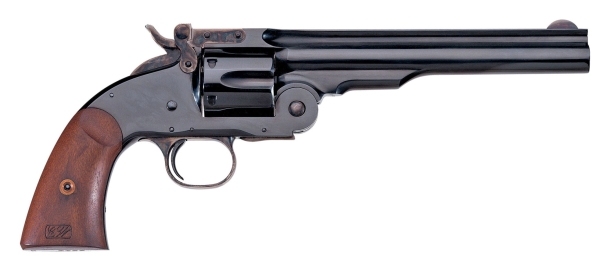
Uberti replica of the 1875 Smith e Wesson Model 3 "Schofield"
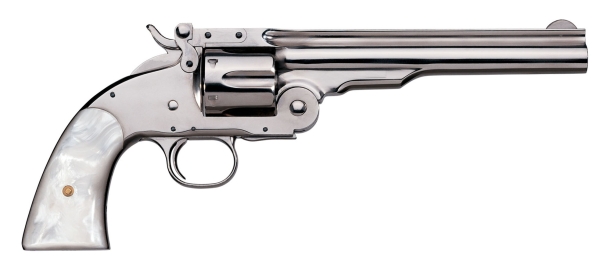
Uberti replica of the 1875 Smith e Wesson Model 3 "Schofield"
The Schofield also had a larger grip, squared off unlike the rounded ones of the Russian and American, and the grip was rounded where it met the frame, whereas the other two models presented a more or less marked spur.
But the main change that distinguished the Schofield model from the previous Smith & Wesson "American" and "Russian" models concerned the frame locking latch, which had been redesigned by Major George W. Schofield.
On previous models, the frame locking latch was on the top strap and acted on two integral lugs, but the lugs could wear out, creating problems. The latch was then moved to the frame, with a hardened steel tenon screwed onto the top strap. Both parts were replaceable when worn out.
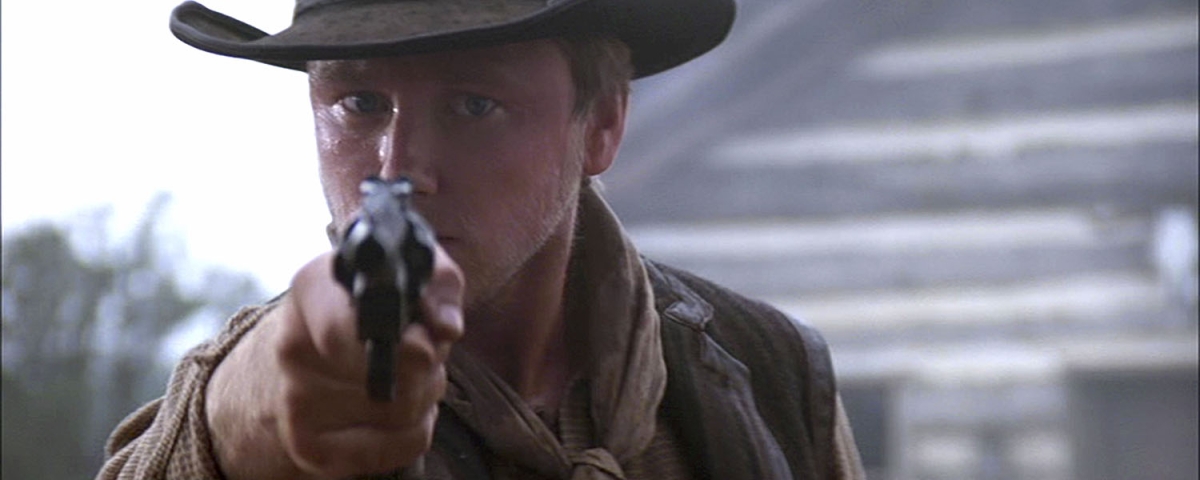
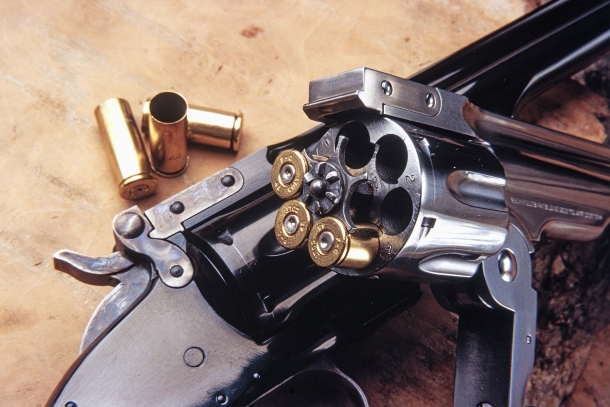
The top break design made unloading and reloading much easier and faster than closed frame, fixed cylinder revolvers of the same period
The Schofield was a very practical weapon, well balanced and quick to reload: by tilting the frame, spent cases were ejected, exposing the empty cylinder and allowing a well-trained shooter to load 2 or even 3 cartridges at a time.
The negative aspect of this system, however, was that by opening the frame any cartridge that had not been fired were also ejected; the weapon was also considered more difficult to reload from horseback than the Colt Single Action Army, as the movement of the horse could easily knock cartridges out of the cylinder, if they weren't somehow held in place. The revolver was also more complex and expensive to manufacture than the Colt. These two factors contributed to the Colt becoming more successful.
Nonetheless, the Smith & Wesson Schofield was one of the most popular revolvers in the West. It was modern, accurate and, not unlike today, the fact that it was the favorite weapon of famous (or infamous) figures played a big role in its popularity.
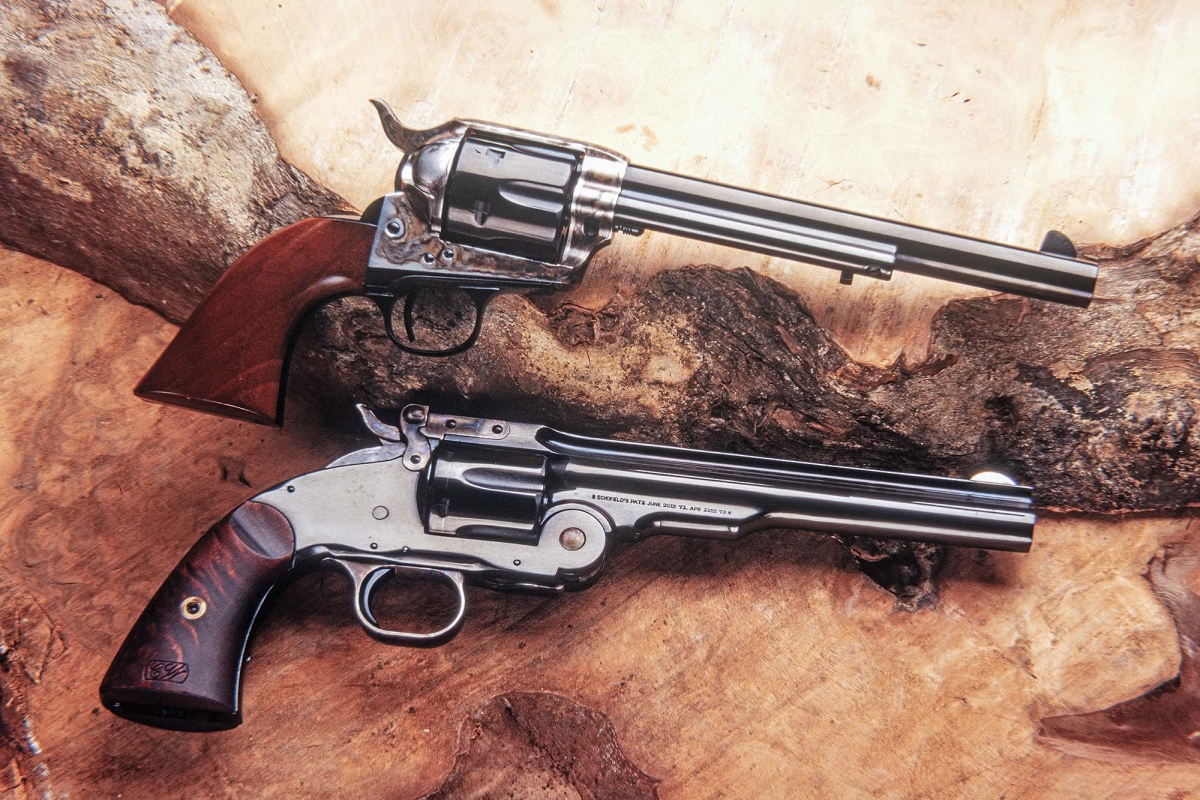
The two main service revolvers of the US cavalry in the twenty years 1870-1890, and beyond.
Uberti replicas - Top, the Colt 1873 Single Action Army; bottom, the 1875 Smith & Wesson Model 3 "Schofield".
Mechanically more sophisticated and modern, during military operational service the Smith & Wesson Model 3 revolvers could not stand comparison with the operational simplicity and robustness of the Colt 1873 revolvers.
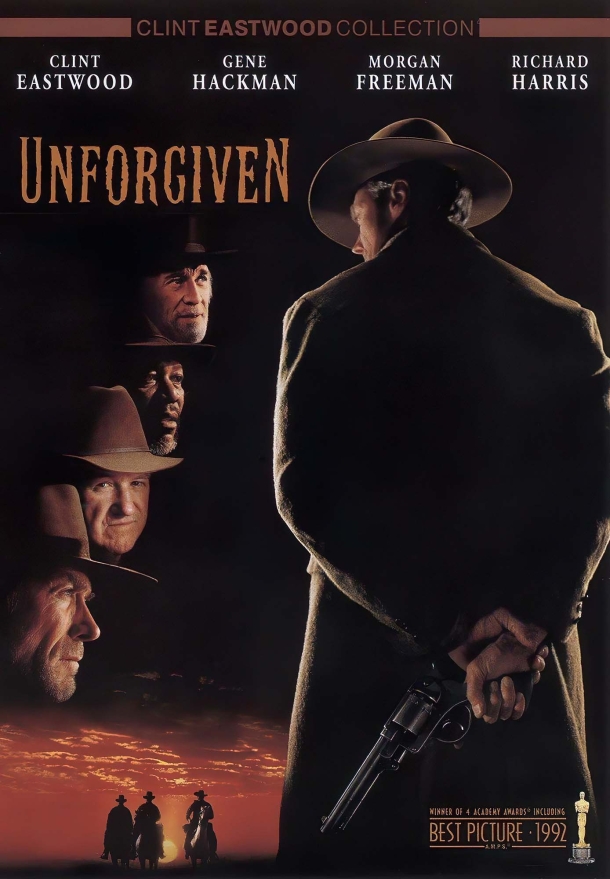
“Unforgiven” 30 years: the Smith & Wesson Schofield 1875 revolver
In the context of "Unforgiven", this model therefore makes sense within the movie screenplay, in the hands of the young and inexperienced Schofield Kid, who probably had chosen it precisely because it was used by famous gunslingers of the time.
It certainly works well for taking out one of the culprits (Quick Mike) in the toilet scene, and then into the hands of Munny himself in the final shootout at Skinny's Saloon, even if one could argue that it’s quite irrelevant which gun the old outlaw is toting, as Munny’s ferocity, utter disregard for human life and, above all, his cold blood in front of lethal danger, in the end decide the outcome of the battle.
The film sparked a huge wave of interest in the Schofield which, unlike the Starr 1858, was always so popular that Smith & Wesson itself put it back into production between 2000 and 2003, albeit with significant changes on the general quotas and on the frame-mounted firing pin.
The Uberti is a more faithful reproduction, the only differences from the original being the thicker top strap and the longer cylinder and frame to accept the .45 Colt cartridge, which as said is longer than the original .45 S&W used on the original models (a modification that Smith & Wesson should have done immediately, in 1875, to better compete with the Colt 1873).
The Uberti Replica of the Smith & Wesson Model 3 "Schofield" is available in all of the chamberings popular in Cow Boy Action Shooting: .38 Special, .44/40, .45 Colt and also in the original .45 Schofield, both long barreled and short, and also in a nickel-plated version with grips both in ivory and polymeric mother-of-pearl.



